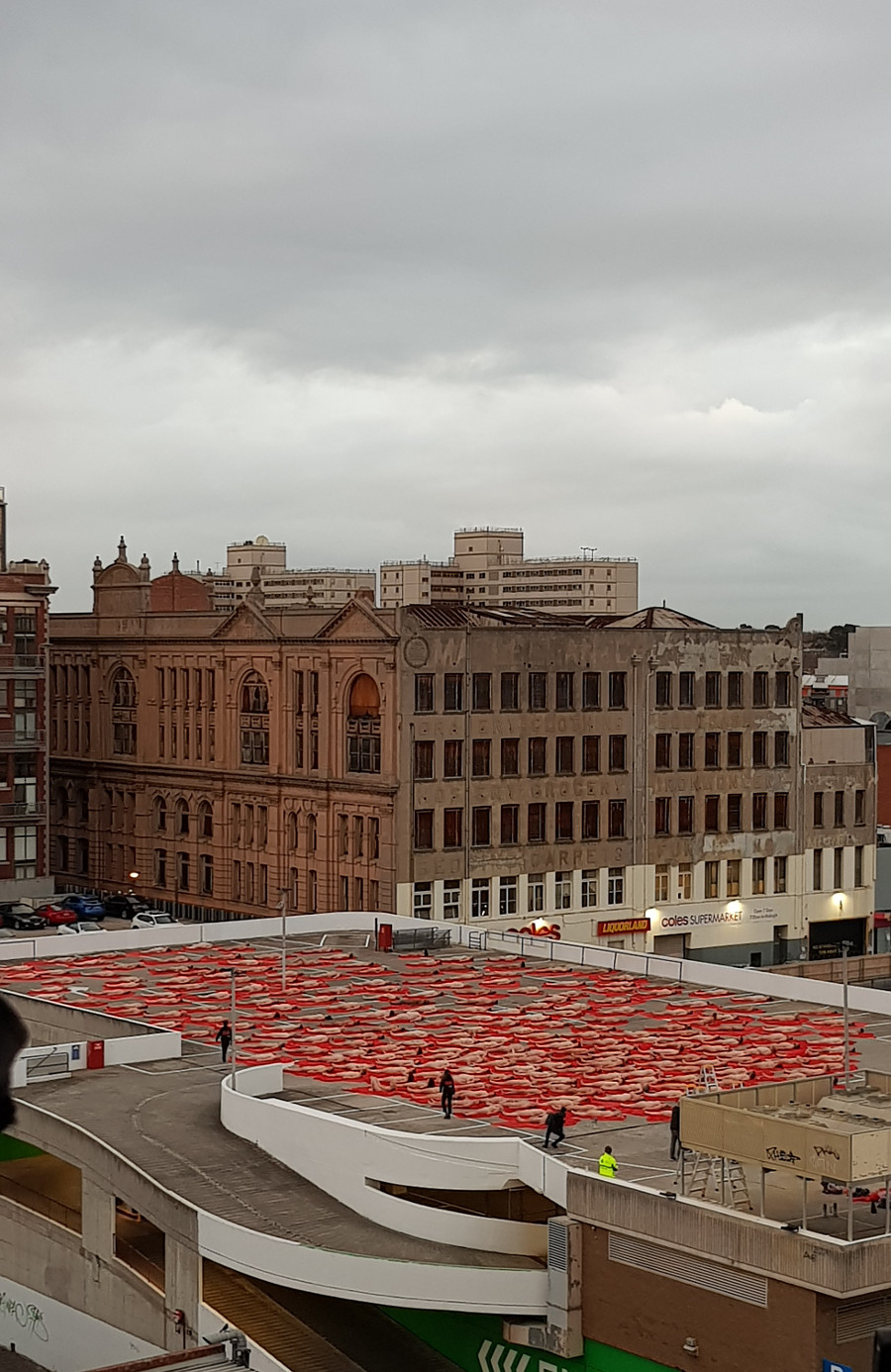Monday morning, 7:05AM.
Spencer Tunick appears on the rooftop level of the Woolworth’s carpark in Prahran, Melbourne. Flanked by team members, he surveys the location set to host the next of his world-famous nude photo installations. He seems composed, focused.
Last month, Tunick nearly lost access to the site following a disagreement with Woolworths. It was devastating; the site had immediately appealed to him during location scouting in January.
“The festival asked me to do something bold that would engage the public. I knew this location was ideal to create something provocative, transcendent…a gift to everyone who is participating”, he commented in an interview with The 8 Percent earlier this year.
Fortunately, the decision was reversed, and Tunick was allowed to achieve his vision.
About 20 minutes later, he gives the sign for the 350 participants to make their way up from their meeting place at The Emerson. Aged 18 – 78, they exit the building in single file, but soon bunch into groups as they make their way past the markets and across the road, each carrying a red bundle in hand.
There’s a sense of excitement within the group. 12,000 people applied to be part of the installation – significantly more than in 2010, when Tunick used the steps of the Sydney Opera House to stage his installation Mardi Gras: The Base – but only 547 were selected for the three pieces being produced at this year’s PROVOCARÉ Festival on Chapel Street.
Jane Louise was quick to jump at the opportunity. “Spencer Tunick is legendary for (his) subversive art, (and) I feel like Melbourne could definitely do with a dose of that, so definitely wanted to get involved.”
It seems as if, as they walk, the city comes to life around them. The sun comes out. The streetlights switch off. There’s some cloud cover, making for a warmer morning than average in mid-winter Melbourne, and the wind that has assailed the area over the last week has finally abated.
“It was cold, and that’s okay”, said one of the participants, Belle Harvey.
“It was really lovely to be connecting with people in a way that was different.”
Roshane Wickramathilake put it simply: “It’s a once in a lifetime kind of thing”.
As they arrive on the rooftop, Tunick directs them with a megaphone to congregate on the far side of the building. Here, after everyone is settled, he calls for everyone to undress. Chloe Horler, who revealed she has struggled with body issues, admits she was a little bit apprehensive to begin with, but felt immediately comfortable once everyone was naked.
Louise, a life model, echoes the sentiment.
“Once you get in the zone…and everyone’s on the same level, and you get focused on ‘this is less about me, and more about achieving art’.”
There’s a cheer as everyone gets naked, then silence. The excitement has given way to respect – respect for Tunick, and his work.
It’s then that the purpose of the red bundles is revealed. They are sheets of opaque, red fabric, and each participant wraps them around their naked bodies like a cloak. Fans of Tunick’s work might recall pieces such as Desert Spirits, his 2013 installation for Burning Man. Where the pieces most notably differ is in the intent. While the fabric used in Desert Spirits blended its subjects into the background, here subjects explode in contrast to the traditional brown buildings that surround the location.
Over the following 30 minutes, Tunick instructs participants to take a range of poses, from covering their entire bodies. Though Harvey said there was the occasional laugh amongst participants, Tunick brought them back into line with polite efficiency.
On balconies around the carpark, onlookers watched on silently. They too are silent as they watched the installation unfold, aware of the gravity surrounding it, even if it seems like a few were caught unexpected.
And then it is over. A cheer goes up, and Tunick raises his hands triumphantly.
“I worked quickly to keep them from freezing, and I think I got some beautiful artworks.”
Nobody runs to get dressed. In fact, many are deliberately slow returning to their clothes, preferring instead to chat with their companions or play with the fabric. They have forgotten the cold. Forgotten the early morning start. For now, there is only the present, and the experience that Tunick has brought them. They will go about their day – some, possibly, to homes or jobs mere metres away – knowing that their bodies have made an indelible mark on the cultural history of this city.
—
Spencer Tunick’s exhibition is part of the PROVOCARÉ Festival of the Arts, which runs July 5 – 15. For more info, visit provocare.com.au

